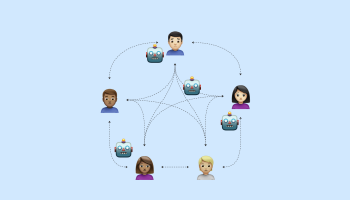We all grew up watching sci-fi movies like Terminator, wondering if there would come a time when robots would take over the world. While that possibility is still far from becoming a reality in the near future, machines (or more specifically, artificial intelligence) have started integrating into our business, but for all the right reasons.
In this post, we’ll break down the key steps on how to implement AI in business. Whether you’re looking to automate tasks, enhance customer experiences, or make better data-driven decisions, this guide will help you approach AI integration with clarity and confidence.
What is artificial intelligence (AI)?

In the simplest terms, artificial intelligence is a machine-learning software that can mimic human intelligence. We call them intelligent systems, but they cannot think for themselves – hence the term mimic.
How they work is by learning from data of any form (like text, images, voices, etc.), recognising patterns in that data and understanding natural language (such as the way we talk and what kind of answers we are looking for). After processing huge amounts of data, testing and training on them, it then works on new data to solve problems or perform tasks.
But why do we need a machine when humans can do these tasks just as well? That is a myth. While humans can solve problems and perform tasks, they cannot do it as quickly and efficiently as AI, for two reasons:
- It can process millions of data points in just seconds
- It can uncover patterns that we might miss or overlook
What humans can do in an hour, AI can finish in milliseconds. That is why more and more companies are using artificial intelligence to enhance their operations.
For a deeper dive into this topic, check out our article: What does artificial intelligence mean?
How to implement AI in business: Key steps

Now that you know what artificial intelligence is, let’s move on to the real thing: how to implement AI in a business, from scratch. It is a 5-step process, and we have discussed what each step entails below:
1. Conduct a thorough analysis of business needs
Before starting any of the technical stuff, you need to first figure out why your company needs AI, and more importantly, what it can do for you.
You have to identify specific challenges or bottlenecks that are slowing down your business or decreasing productivity. Ask yourself questions like:
- Am I spending too much time on monotonous tasks that can be automated?
- Do I face any problems with retaining customers or lead conversion?
- How are my marketing campaigns fairing? Do I need to improve them?
You have to find the “pain points” of your business where AI can offer real value. A common mistake that startups or SMEs make is that they try to integrate AI just for the sake of it, without any clear direction or goal to achieve with it. In this case, it becomes a waste of their energy and resources, and they often end up with complex systems that they don’t fully understand, poor ROI, and frustrated team members.
2. Evaluate and organise your data
AI runs on data, so you need to know what you have and what you’re missing. The kind of data you need depends on the use case – it could be customer interactions, sensor data, documents, or transactions.
Review the quality, accessibility, and organisation of your data. Is it clean? Is it stored in one place or scattered across tools? The more structured and centralised your data is, the easier it will be to train and apply AI models effectively.
3. Identify suitable AI tools and technologies
The next step is to identify the right tools and models to integrate the artificial intelligence system into your business operations.
There are two main routes you can go with:
- Off-the-shelf tools: Like chatbots (e.g., Intercom), AI CRMs (e.g., Salesforce Einstein), or document scanners.
- Custom AI solutions: Ideal for complex or business-specific challenges, like building a fraud detection model, a recommendation engine, or custom process automation.
Custom AI may sound expensive, but it is often more scalable, adaptable, and can be aligned with your specific business goals.
If you’re not ready to hire AI experts in-house, a trusted development partner can help you plan and build a tailored solution that fits your needs and budget.
Need Help Integrating AI into Your Business?
Our expert AI consultants guide you through every step, from strategy and use case selection to full-scale AI implementation.
AI consulting
4. Develop a strategy for implementation
So now that you have identified how you are going to use AI for your company, the next step is to develop a strategy. This is the stage where you map out:
- The milestones for your AI integration project
- Who will be responsible for what
- Setting timelines and success metrics
Many companies skip this step and jump straight into deploying tools. But without a clear roadmap, it’s easy to go off track, spending more time and money than planned, or losing focus on the original goal.
This is where a partner like GoodCore Software can make a big difference. With our experience in custom AI solutions, we help businesses build well-paced AI strategies that align with both technical and business goals.
Whether you need help mapping out your implementation, choosing the right architecture, or ensuring long-term scalability, we’re here to guide you through each step, avoiding common pitfalls and delivering real, measurable results.
5. Start small with a pilot project
One of the most common mistakes businesses make is trying to do too much, too soon. Instead, pick a small, focused project to test AI in a real environment without high risk. Good pilot projects are:
- Low-cost and quick to implement
- Easy to measure in terms of success/failure
- Relevant to your broader goals
For instance, instead of automating your entire customer support process, you could start by using an AI tool to analyse support tickets and flag common issues. This approach helps build internal experience, show early results, and reduce resistance to change across the organisation.
6. Train and involve your team
AI should support your team, not replace or confuse them. It’s important to involve relevant team members early on, especially the ones who will use or interact with the system day-to-day. Provide clear training on:
- What the AI system does (and doesn’t do)
- How to interpret its outputs
- What to do when results seem off or unclear
- How to provide feedback to improve the system
7. Monitor and evaluate AI performance
The last step is an ongoing cycle of monitoring and evaluating AI performance. This comes after you have integrated AI tools in your business. It is an iterative process, where you will need to regularly:
- Check if the system is delivering value-driven results
- Tweak algorithms based on feedback (from employees and customers) and as new data comes in
- Adjust/scale the AI model(s) as your business evolves
This is how you can make your system smarter over time and ensure that your ROI gets better month after month.
Benefits of integrating AI into your business
Here are a couple of reasons why AI can be beneficial for your company:
Increased efficiency and productivity
One of the biggest reasons businesses turn to AI is to get more done in less time. AI can automate repetitive, time-consuming tasks like: data entry, scheduling, or sorting emails, so your team can focus on higher-value work.
For example, AI tools can quickly analyse large sets of data, generate reports, or even respond to customer inquiries through chatbots. This not only speeds things up but also reduces the chance of human error. The result? A more efficient workflow and a team that’s free to focus on what really matters.
Improved decision-making and insights
AI does not just process data; it understands it. You can input data like past sales, customer behaviour or previous market trends. Based on historical data, the AI will recognise patterns, analyse them and give strategic insights that can help you make business decisions faster and more confidently.
Artificial intelligence can help you analyse:
- Which products are most likely to sell in the next quarter (so you can be prepared beforehand)
- Successful marketing campaigns that are driving the best ROI (so you can focus your resources on these campaigns)
- Which customers are at risk of leaving (so you can offer personalised strategies to retain them)
What’s more? Not only does AI give insights, but it also predicts what might happen and what to do based on these insights.
Enhanced customer experience
Ever wondered how Spotify recommends the perfect song that you end up vibing with? Or how Netflix suggests to you a ‘your next watch’ that is probably different from what it suggests to your parent or child? That is AI pulling the strings behind the screen.
Another example is Temu. If you have visited the app even once, then you’ll know how their marketing campaigns can be. From personalised Temu ads appearing on your Instagram to receiving emails every other day. You might think they have a huge team working on it 24/7. But it is just AI doing the job for them, much more quickly and efficiently.
Competitive advantage in the market
Adopting AI early gives your business a real edge. It allows you to act on insights faster, make better decisions, and respond to changes in your industry with confidence.
For instance, AI can help you spot inefficiencies or opportunities in your operations that aren’t obvious at first glance. With the right tools, you can reduce delays, optimise pricing, or improve service quality, all of which directly impact your bottom line.
While others are still figuring out how to react, you’re already moving forward with data-driven clarity. That kind of agility is hard to compete with.
Common challenges of integrating AI into business
While artificial intelligence can revolutionise your workflow, it is possible that you might face some problems when implementing it into your business. Here are some common challenges that you might face and how you can solve them:
| Challenge | Solution | |
| 1 | Not enough AI knowledge or resources to form a team | Work with experienced AI consultants or use ready-made AI tools to get started |
| 2 | Data privacy can be at risk | Hire developers that follow data protection laws (like GDPR) and use trusted tools with strong security |
| 3 | Old systems don’t connect well with AI | Start with small changes and use connectors (APIs) or middleware to connect old systems with new AI tools |
| 4 | Team is unsure or resistant to this new change | Involve your team early, explain the benefits clearly, and provide proper training |
Best practices for successfully implementing AI in business
Here are a few tips from our experts that can help you out along this AI integration journey:
- Start with small pilot projects: Begin with one problem or department. Gather data, test solutions, and prove ROI before scaling up.
- Encourage collaboration between AI and human intelligence: Use AI to assist your team, not replace them. Maintain a balance between the two and let your team make the final decisions when the stakes are high.
- Continuously optimise AI algorithms through an iterative process: Collect feedback. Tweak. Improve. AI gets better over time, but only if you are actively working on refining it.
- Consider the costs and ROI of AI implementation: Don’t just look at upfront costs. Think long-term and strategise accordingly.
- Ensure alignment with overall business goals: Always ask: How will this help my customers, or what is the bottom line if I do this?
Final thoughts
AI is rapidly transforming the way our businesses operate in a positive way. All you need is a clear objective, the right tools, and a willingness to learn and adapt.
And if you are looking for a trusted partner to guide you through AI integration, we are here to offer expert consulting and AI solutions.
Turn AI Potential Into Business Results
Whether you’re just getting started or scaling your AI efforts, we help you plan, build, and integrate AI solutions that drive value.
Learn more
FAQs
How long does it take to set up AI in my business?
The time it takes to implement AI in business can vary depending on the scope of the project. For smaller use cases, like automating reports or integrating an AI-powered chatbot, implementation can take 4 to 6 weeks, especially if you’re using existing tools. More complex projects, such as building custom AI models or integrating with multiple systems, typically take 3 to 6 months or more, depending on data readiness and technical requirements.
What’s the difference between AI and machine learning?
AI (Artificial Intelligence) is a broad field focused on creating systems that can perform tasks that typically require human intelligence—like problem-solving, understanding language, or recognizing patterns. Machine learning (ML) is a subset of AI that enables systems to learn from data and improve over time without being explicitly programmed. In simple terms, AI is the overall concept, and ML is one of the main ways we build and train AI systems.





